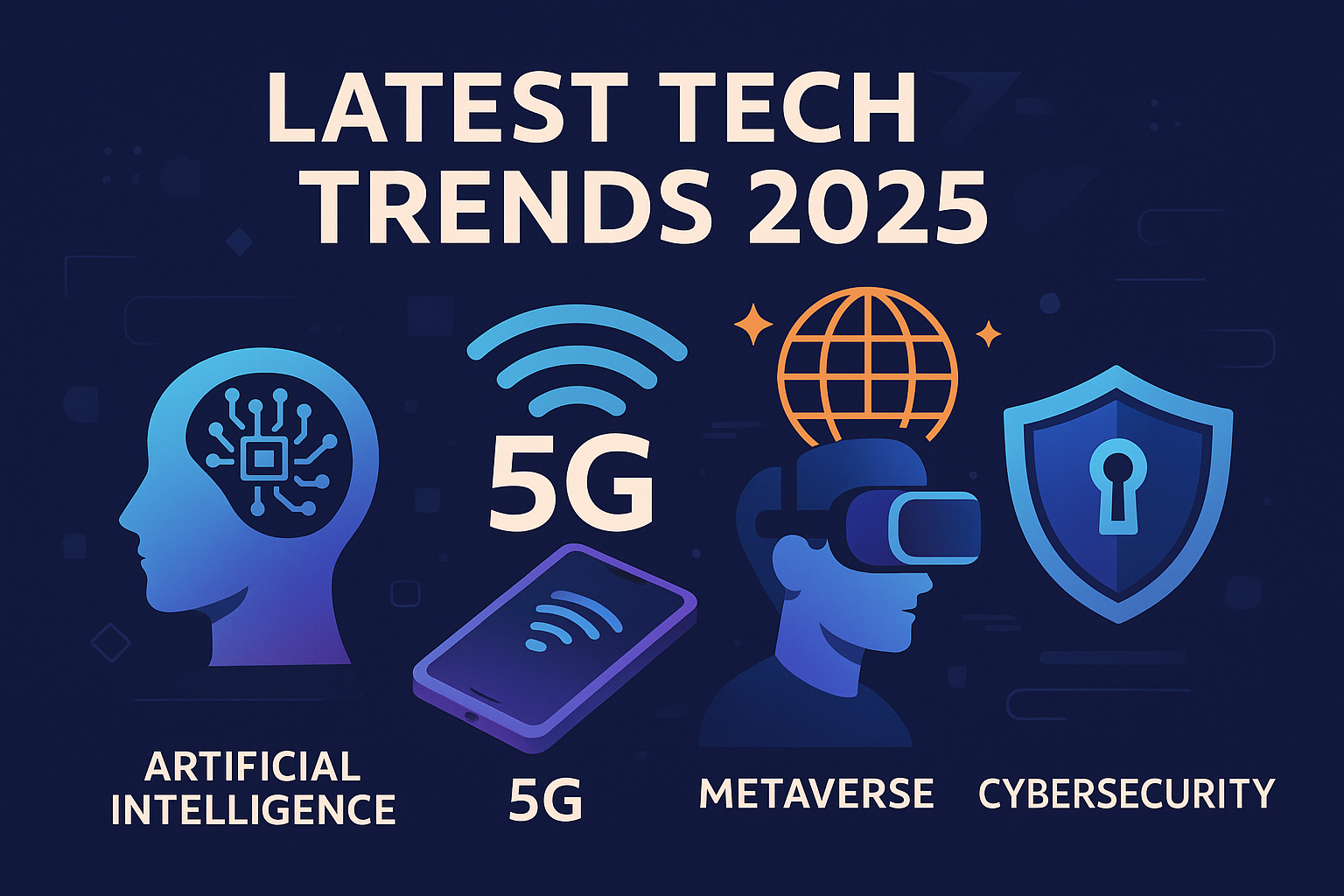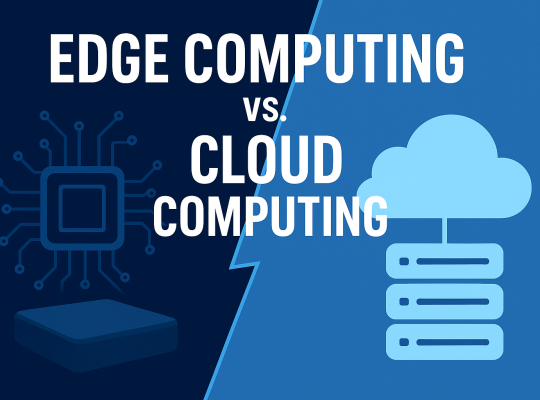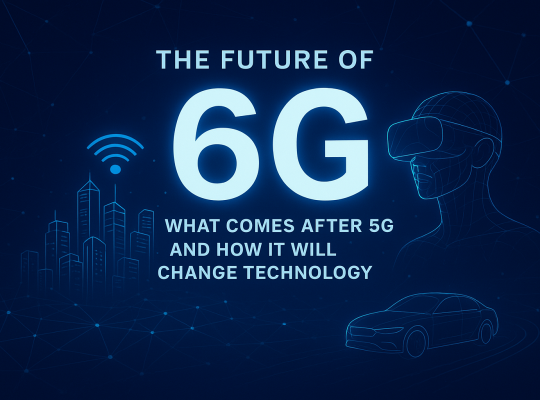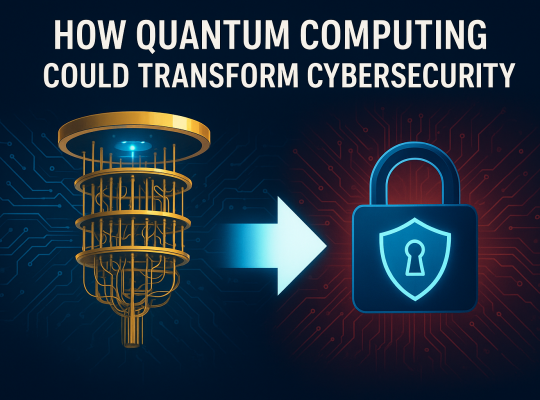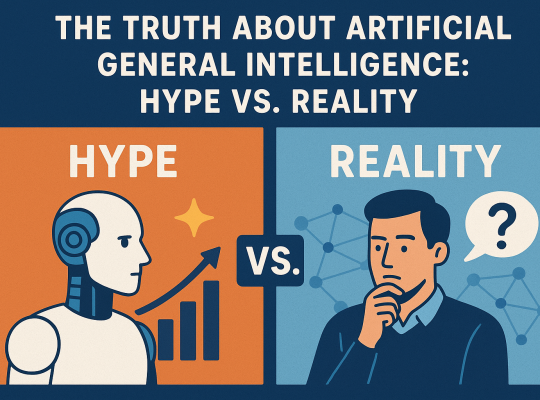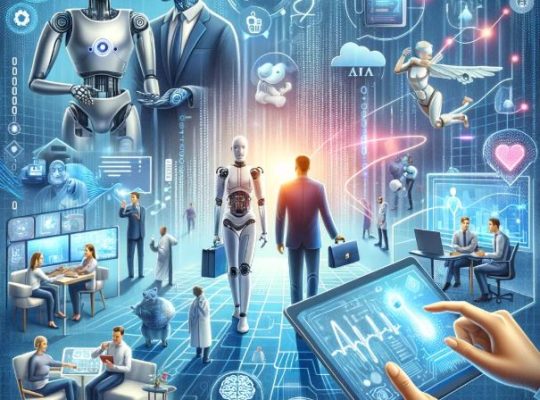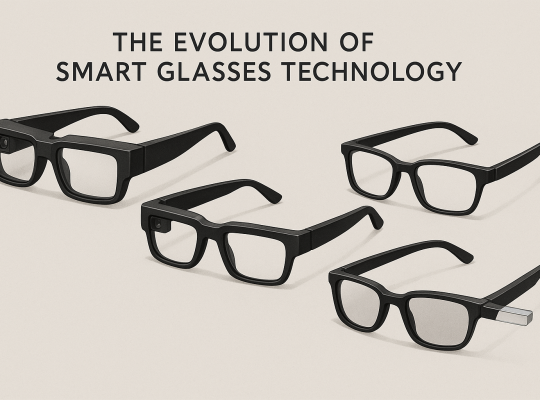As we stand on the brink of a technological renaissance, the year 2025 promises to unveil groundbreaking innovations that will redefine our everyday lives. From artificial intelligence to sustainable tech solutions, the future is brimming with possibilities that can enhance how we interact, work, and navigate the world around us. But what are the key tech trends that will take center stage and shape our future? This article delves into the top 10 tech trends to watch in 2025, exploring the transformative advancements that not only hold the potential for economic growth but also aim to address some of the planet’s most pressing challenges. Join us as we uncover the technologies that will drive change, fuel imagination, and pave the way for a smarter, more connected world. Get ready to embrace the future, where innovation meets aspiration.
Artificial Intelligence and Machine Learning Advancements
Artificial Intelligence (AI) and Machine Learning (ML) have been the cornerstone of many technological advancements over the past decade, and by 2025, their impact is expected to be even more profound. AI’s ability to analyze vast amounts of data and learn from it enables the development of systems that can perform tasks that traditionally required human intelligence. This includes everything from recognizing speech and images to making complex decisions. ML, a subset of AI, focuses on developing algorithms that allow computers to learn from data and improve over time without being explicitly programmed.
One of the most promising advancements in AI and ML is the development of more sophisticated natural language processing (NLP) systems. These systems are becoming increasingly adept at understanding and generating human language, making interactions with machines more intuitive and natural. This will lead to more advanced virtual assistants and chatbots that can handle a wider range of tasks and provide more personalized experiences for users. Additionally, AI-powered translation services are expected to break down language barriers, facilitating smoother global communication.
Moreover, AI and ML are poised to revolutionize industries such as healthcare, finance, and transportation. In healthcare, AI-driven diagnostics and treatment recommendations can enhance patient care and outcomes. In finance, AI algorithms can analyze market trends with unprecedented accuracy, enabling more informed investment decisions. Autonomous vehicles, powered by AI, are set to transform transportation by improving safety and efficiency. The continuous integration of AI and ML into various sectors highlights their potential to drive innovation and economic growth.
The Rise of Quantum Computing
Quantum computing represents a paradigm shift in how we process information, leveraging the principles of quantum mechanics to solve problems that are currently beyond the reach of classical computers. By 2025, significant strides are expected in this field, potentially leading to breakthroughs in cryptography, material science, and complex system simulations. Unlike classical computers, which use bits to represent data as 0s or 1s, quantum computers use qubits that can exist in multiple states simultaneously, allowing for exponentially greater processing power.
One of the most exciting applications of quantum computing is in the realm of cryptography. Quantum computers have the potential to break current encryption methods, which could pose a significant risk to data security. However, they also offer the promise of developing new, unbreakable encryption techniques that could revolutionize cybersecurity. This dual capability underscores the importance of quantum computing in the ongoing battle to protect sensitive information in an increasingly digital world.
In addition to cryptography, quantum computing holds promise for advancing fields such as drug discovery and materials science. The ability to simulate complex molecular interactions at an unprecedented scale could lead to the development of new pharmaceuticals and advanced materials with unique properties. Furthermore, quantum computing could enhance our understanding of fundamental physical processes, opening new avenues for scientific exploration. As research and development in this area continue, the potential applications of quantum computing are bound to expand, driving innovation across multiple domains.
5G Technology and Its Impact on Connectivity
The rollout of 5G technology marks a significant milestone in the evolution of wireless communication, promising faster speeds, lower latency, and greater capacity than its predecessors. By 2025, 5G is expected to be widely adopted, transforming how we connect and interact with the world around us. This next-generation network will enable a host of new applications and services, from enhanced mobile broadband to the Internet of Things (IoT) and beyond.
One of the most immediate benefits of 5G technology is the dramatic increase in data transfer speeds. This will enable seamless streaming of high-definition content, faster downloads, and more responsive online gaming experiences. Additionally, the reduced latency of 5G networks will make real-time communication and remote control of devices more reliable and efficient. This is particularly important for applications such as telemedicine and remote surgery, where even slight delays can have critical implications.
Beyond consumer applications, 5G technology is set to drive innovation in various industries. For example, in manufacturing, 5G-enabled smart factories will leverage IoT devices and sensors to optimize production processes, reduce downtime, and enhance overall efficiency. In transportation, 5G will support the development of connected and autonomous vehicles, improving safety and traffic management. The widespread adoption of 5G will also facilitate the growth of smart cities, where interconnected systems work together to enhance the quality of life for residents. The impact of 5G on connectivity is poised to be transformative, paving the way for a more interconnected and intelligent world.
The Evolution of Augmented Reality (AR) and Virtual Reality (VR)
Augmented Reality (AR) and Virtual Reality (VR) have been gaining traction over the past few years, and by 2025, they are expected to become mainstream technologies with applications that span entertainment, education, healthcare, and beyond. AR enhances the real world by overlaying digital information, while VR creates entirely immersive digital environments. The evolution of AR and VR technologies will enable new forms of interaction and experiences that were previously unimaginable.
In the realm of entertainment, AR and VR are set to revolutionize how we consume media and engage with content. VR headsets will offer more immersive gaming experiences, transporting players into virtual worlds where they can interact with their environment in ways that were not possible before. AR will enhance live events, such as concerts and sports, by providing real-time information and interactive elements that enrich the audience’s experience. The blending of digital and physical worlds will create new opportunities for storytelling and creative expression.
Education is another sector that stands to benefit significantly from AR and VR technologies. These tools can create immersive learning environments that make education more engaging and interactive. For example, VR can take students on virtual field trips to historical sites or distant planets, providing a deeper understanding of the subject matter. AR can be used to visualize complex concepts, such as anatomical structures or chemical reactions, in a more intuitive and accessible way. The integration of AR and VR in education has the potential to enhance learning outcomes and make education more accessible to a broader audience.
In healthcare, AR and VR are already being used for medical training, surgical planning, and patient therapy. VR simulations allow medical professionals to practice procedures in a risk-free environment, improving their skills and confidence. AR can assist surgeons by overlaying critical information, such as patient vitals and anatomical landmarks, during operations. For patients, VR therapy has shown promise in treating conditions such as anxiety, PTSD, and chronic pain by creating controlled and immersive therapeutic environments. The continued advancement of AR and VR technologies will further expand their applications, driving innovation and improving outcomes in various fields.
Internet of Things (IoT) and Smart Home Innovations
The Internet of Things (IoT) refers to the network of interconnected devices that communicate and exchange data with each other. By 2025, IoT is expected to become even more pervasive, with smart home innovations leading the charge. IoT devices, ranging from smart thermostats to connected appliances, will transform our living spaces, making them more efficient, convenient, and secure. The integration of IoT into our daily lives will create a seamless and interconnected ecosystem that enhances our quality of life.
One of the key benefits of IoT in smart homes is the ability to automate routine tasks and optimize energy consumption. Smart thermostats can learn residents’ preferences and adjust heating and cooling settings accordingly, reducing energy waste and lowering utility bills. Connected lighting systems can be programmed to turn on and off based on occupancy, further enhancing energy efficiency. Smart appliances, such as refrigerators and washing machines, can monitor usage patterns and provide maintenance alerts, ensuring optimal performance and longevity.
Safety and security are also paramount in smart home innovations. IoT-enabled security systems, including smart locks, cameras, and motion sensors, provide real-time monitoring and alerts, allowing homeowners to keep an eye on their property from anywhere. These systems can be integrated with other smart devices to create comprehensive security solutions that respond to potential threats. For example, if a smart camera detects unusual activity, it can trigger lights and alarms to deter intruders and notify the homeowner immediately.
The convenience offered by IoT devices extends beyond energy management and security. Voice-activated assistants, such as Amazon Alexa and Google Assistant, allow users to control various aspects of their smart home with simple voice commands. This hands-free interaction makes it easier to manage daily tasks, from setting reminders to controlling entertainment systems. As IoT continues to evolve, the range of smart home innovations will expand, offering even greater convenience and enhancing our overall living experience.
Blockchain Technology Beyond Cryptocurrency
Blockchain technology, best known as the underlying technology for cryptocurrencies like Bitcoin, has far-reaching applications that extend beyond digital currencies. By 2025, blockchain is expected to revolutionize various industries by providing secure, transparent, and decentralized solutions. The immutable nature of blockchain ledgers makes them ideal for applications that require trust and verifiability, from supply chain management to digital identity verification.
One of the most promising applications of blockchain is in supply chain management. Traditional supply chains often suffer from a lack of transparency and traceability, leading to inefficiencies and vulnerabilities. Blockchain can address these issues by providing a secure and transparent record of every transaction and movement of goods. This enables all stakeholders, from manufacturers to consumers, to verify the authenticity and provenance of products. For example, in the food industry, blockchain can be used to trace the journey of produce from farm to table, ensuring food safety and quality.
Digital identity verification is another area where blockchain holds significant potential. The current methods of identity verification are often cumbersome and prone to fraud. Blockchain can provide a more secure and efficient solution by creating a decentralized and immutable record of identities. This can simplify processes such as KYC (Know Your Customer) in financial services, where verifying the identity of clients is crucial for regulatory compliance. Blockchain-based digital identities can also empower individuals by giving them control over their personal information and how it is shared.
Beyond supply chain management and digital identity, blockchain technology is poised to impact various other sectors. In healthcare, blockchain can provide secure and interoperable health records, improving patient care and data integrity. In the legal field, smart contracts—self-executing contracts with the terms directly written into code—can automate and enforce agreements without the need for intermediaries. The potential applications of blockchain are vast, and as the technology matures, it is likely to drive innovation and efficiency across numerous industries.
Sustainable Tech: Innovations for a Greener Future
As the world grapples with the urgent need to address climate change and environmental degradation, sustainable technology is emerging as a critical area of innovation. By 2025, advancements in sustainable tech are expected to play a pivotal role in creating a greener and more sustainable future. These innovations encompass a wide range of solutions, from renewable energy sources to eco-friendly materials and energy-efficient systems. The focus on sustainability is not only driven by environmental concerns but also by the economic opportunities that green technologies present.
Renewable energy is at the forefront of sustainable tech innovations. The continued development and deployment of solar, wind, and other renewable energy sources are crucial for reducing our reliance on fossil fuels and lowering greenhouse gas emissions. Advances in energy storage technologies, such as batteries and supercapacitors, are enhancing the efficiency and reliability of renewable energy systems. By 2025, we can expect to see more widespread adoption of renewable energy solutions, supported by smart grids that optimize energy distribution and consumption.
In addition to renewable energy, sustainable tech is making strides in the development of eco-friendly materials and products. Innovations in material science are leading to the creation of biodegradable plastics, sustainable packaging, and environmentally friendly construction materials. These advancements are essential for reducing waste and minimizing the environmental impact of various industries. For example, the construction industry is exploring the use of sustainable materials such as recycled steel and low-carbon concrete to build greener infrastructure.
Energy efficiency is another critical aspect of sustainable tech. From smart buildings that optimize energy use to electric vehicles (EVs) that reduce emissions, energy-efficient technologies are transforming how we live and move. The adoption of EVs is expected to increase significantly by 2025, driven by advancements in battery technology and the expansion of charging infrastructure. Smart buildings, equipped with IoT devices and energy management systems, will reduce energy consumption and lower carbon footprints. These innovations highlight the potential of sustainable tech to create a more eco-friendly and economically viable future.
Cybersecurity Trends in an Increasingly Digital World
As our world becomes increasingly digital, the importance of cybersecurity cannot be overstated. By 2025, the landscape of cybersecurity is expected to evolve in response to emerging threats and the growing sophistication of cyber-attacks. With the proliferation of connected devices and the expansion of digital services, ensuring the security and privacy of data is more critical than ever. The future of cybersecurity will be shaped by new technologies, strategies, and regulations aimed at protecting against cyber threats.
One of the key trends in cybersecurity is the adoption of AI and ML to detect and respond to threats. These technologies can analyze vast amounts of data in real-time, identifying patterns and anomalies that may indicate a cyber-attack. AI-driven security systems can automate threat detection and response, reducing the time it takes to mitigate risks. Additionally, ML algorithms can learn from past incidents, continuously improving their ability to predict and prevent future attacks. The integration of AI and ML into cybersecurity will enhance the effectiveness and efficiency of defense mechanisms.
Another significant trend is the emphasis on securing the Internet of Things (IoT). As IoT devices become more prevalent, they present new vulnerabilities that can be exploited by cybercriminals. Ensuring the security of these devices is crucial for protecting not only individual users but also critical infrastructure. This includes implementing robust authentication mechanisms, encrypting data transmissions, and regularly updating software to address security flaws. The development of IoT security standards and best practices will be essential for safeguarding the expanding network of connected devices.
Regulatory frameworks and international cooperation will also play a vital role in the future of cybersecurity. Governments and organizations around the world are recognizing the need for comprehensive cybersecurity policies and regulations. These frameworks will set standards for data protection, incident reporting, and response procedures. International cooperation is necessary to address cyber threats that transcend national borders, facilitating the sharing of information and resources. The collaborative efforts of public and private sectors will be key to building a resilient and secure digital ecosystem.
Conclusion: Preparing for the Future of Technology
As we look ahead to 2025, it is clear that technology will continue to play a transformative role in shaping our world. The advancements in AI, quantum computing, 5G, AR/VR, IoT, blockchain, sustainable tech, and cybersecurity will drive innovation and create new opportunities across various sectors. These technologies promise to enhance our daily lives, address pressing global challenges, and pave the way for a smarter, more connected future.
However, with these advancements come new responsibilities and challenges. Ensuring the ethical development and deployment of technologies is crucial for maximizing their benefits while minimizing potential risks. This includes addressing issues such as data privacy, security, and the potential impact on employment. As technology continues to evolve, it is essential to foster a culture of responsible innovation that prioritizes the well-being of individuals and society as a whole.
In preparing for the future of technology, it is important to stay informed and adaptable. Continuous learning and skill development will be essential for navigating the rapidly changing technological landscape. Embracing a forward-thinking mindset and being open to new possibilities will enable us to harness the full potential of emerging technologies. By doing so, we can ensure that the innovations of 2025 and beyond contribute to a more prosperous, sustainable, and equitable world.
As we stand on the threshold of this exciting future, the possibilities are limitless. The tech trends outlined in this article offer a glimpse into the innovations that will shape our lives in the coming years. By staying engaged and proactive, we can embrace these advancements and work together to build a brighter and more connected future. The journey ahead promises to be one of discovery, creativity, and progress, driven by the relentless pursuit of innovation.

